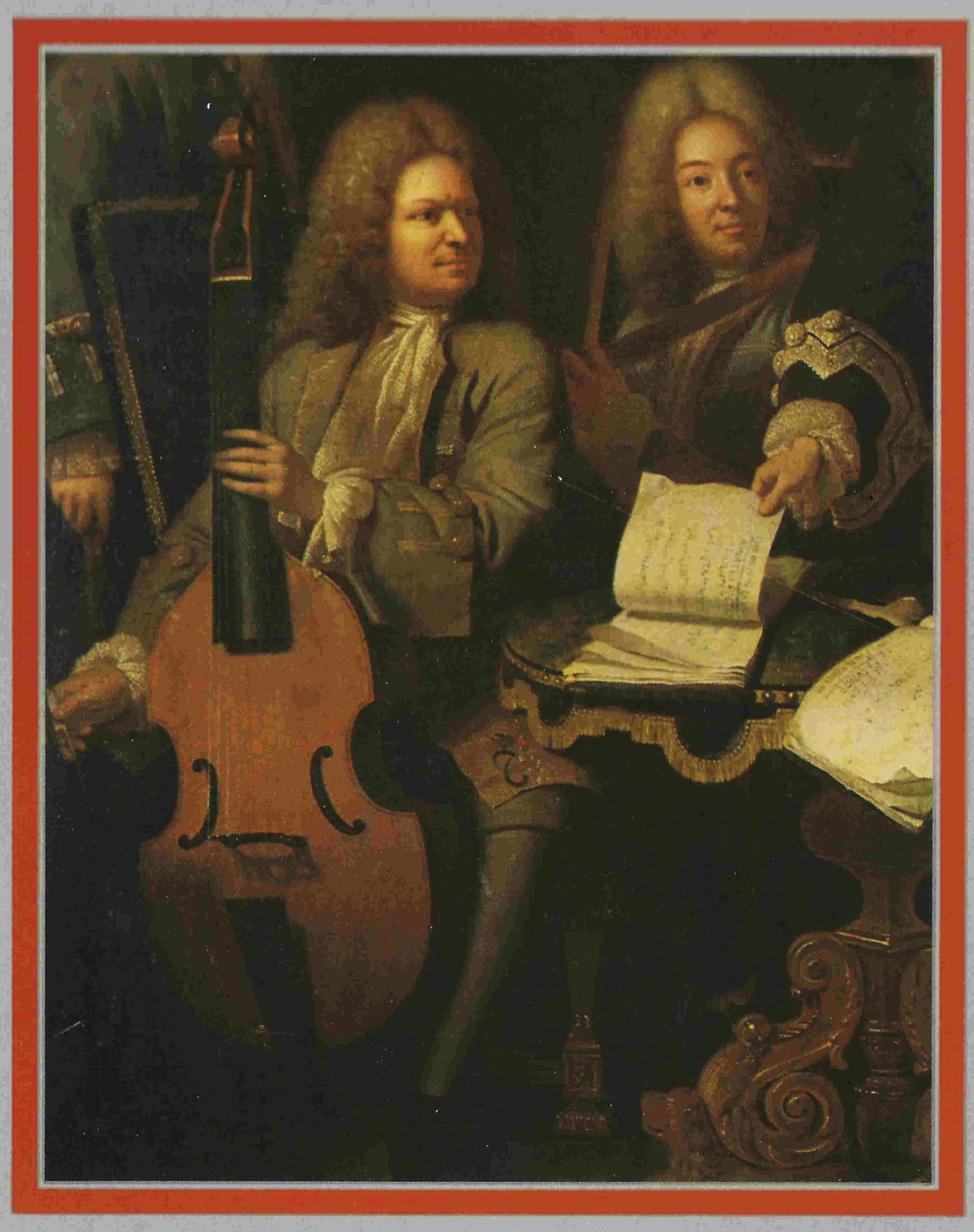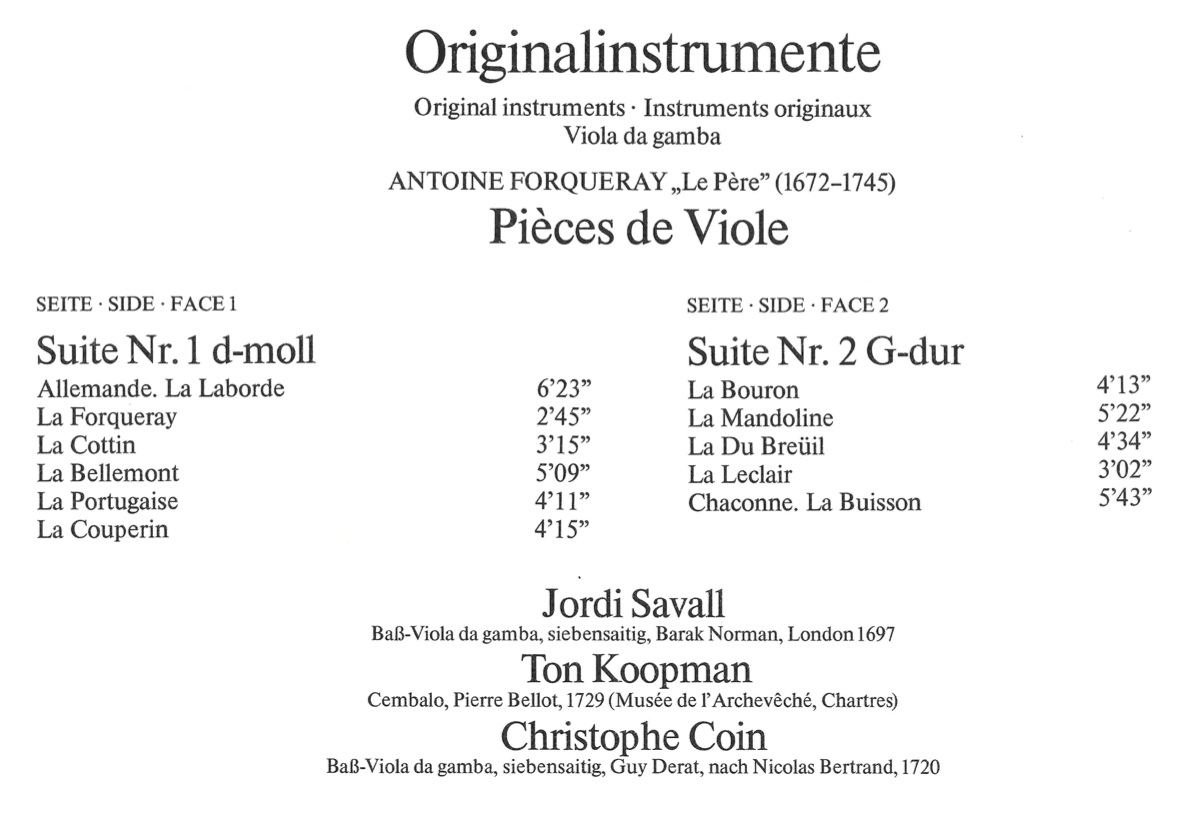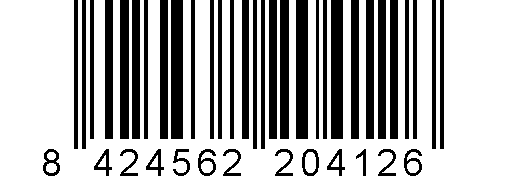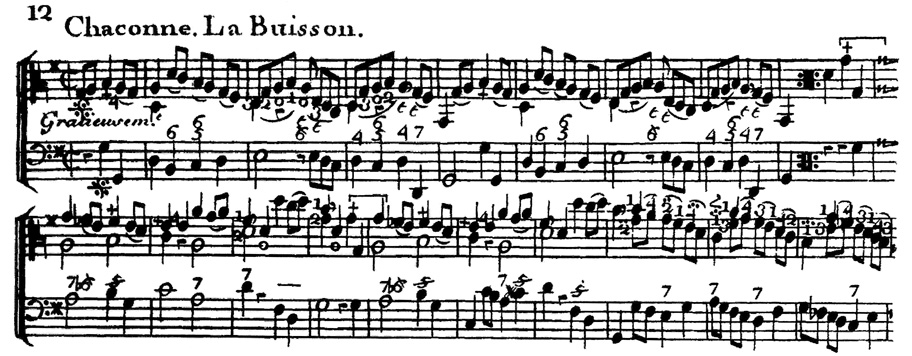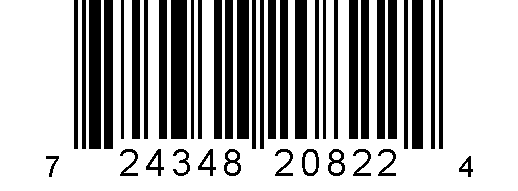Antoine de Forqueray
The Attraction of the Deep
Media Review / Comparison
2012-05-13 — Original posting (on Blogger)
2013-07-16 — New standard layout applied
2014-11-02 — Re-posting as is (WordPress)
2015-02-28 — Addendum 3 about a related blog post by “Ipromesisposi”
2016-06-26 — Brushed up for better readability
Table of Contents
Introduction: Music for Viols
Totally addicted!! In most of baroque Europe, the number of chamber music works for deep string instruments is rather small. Also, viols were very popular in France and in England (to some degree), but rarely used in Italy in baroque times. However, at the French Court there was an entire school of famous viola da gamba players (presumably because the monarch liked or played the instrument).
It’s a pity that this rich-sounding instrument hasn’t been used more and was ultimately abandoned completely in favor of the violin family! In Germany, Bach was one of the last composers who used the viola da gamba where he was looking for special sound effects (e.g., in his passions, for key arias with a particular emotional content), in the sixth Brandenburg concerto, or in his few sonatas for viola da gamba.
Prominent Composers
As for the French school: I have a number of CDs with works for viola da gamba by Marin Marais (1656 – 1728), as well as M. de Sainte-Colombe le fils (ca. 1660 – 1720). I love music for viola da gamba (hence the title of this post). However, recently, I realized that one important composer was missing in my CD library. I still have an LP with music for viola da gamba by Antoine de Forqueray (1671 – 1745), played by Jordi Savall that I haven’t heard in many years. The picture above is from the LP cover; people assume that the man on the left is Antoine Forqueray. I remember very well that this music left a deep impression. So, I looked for that recording on Amazon.de — without success. Luckily I found that a digital version is still available on iTunes:
Recording #1: Jordi Savall, 1977
Antoine Forqueray: Pièces de Viole, Suites I & II
Alia Vox (original LP recording 1977, ℗ 1978); iTunes download, 256 kbps; ℗ 2009

As this download does not include a booklet, I have scanned the backside of the LP cover here; first, the title / pieces / artists:
Then, the text in English, French and German (select any of the images for a full size view):
Jordi Savall, Ton Koopman, Christophe Coin
Now, what is this about? My first encounter with this music was through the recording with Jordi Savall. I was enchanted by his playing and the sound of his beautiful, historic bass viol (7 strings, Barak Norman, London, 1697). Just the full, warm and harmonic, deep sound of this instrument is a pure feast, its richness in harmonics, its powerful resonating body. Added to this is Forqueray’s music. I get the impression that Forqueray must have been one of few super virtuosos on that instrument: his suites (and the five suites are — essentially, see below — all we have from this composer) technically extremely demanding.
Savall is an absolute master of his instrument, and he an absolute sound fanatic, and an uncompromising aesthete! He is accompanied by Ton Koopman on a historic Harpsichord (Bellot, France, 1729), and by Christophe Coin on a 7-string bass viol (replica by Guy Derat, after a model by Nicolas Bertrand, 1720). Koopman does not restrict his accompaniment to filling the ciphered bass notation, but he often adds melodic second voices, counter-points / dialog to the main voice. Christophe Coin’s role is mostly supportive, somewhat inconspicuous. He is reinforcing the bass line, the recording is (of course) dominated by Savall’s playing.
Recording #2: Paolo Pandolfo,1995
While I was looking for the above recording on CD, I ran into a second recording of Forqueray’ Suites, this time with Paolo Pandolfo and his ensemble, so I could not resist:
Forqueray: Pièces de viole avec la basse continuë – Paris, 1747
Paolo Pandolfo, Guido Balestracci, Rolf Lislevand, Eduardo Egüez, Guido Morini
Glossa 8 424562 204126 (2 CD, stereo); ℗ 1995 / © 2011 MusiContact GmbH

I very much like Pandolfo’s playing (I will likely return to recordings with this artist in future postings)!
Paolo Pandolfo, Guido Balestracci, Rolf Lislevand, Eduardo Egüez, Guido Morini
Paolo Pandolfo‘s recording is very different, in several ways! First, and foremost, it sounds as if there is a full octave between Savall and Pandolfo! For a while I indeed thought Savall is playing an octave below Pandolfo. However, closer inspection (thanks to the anonymous commenter for pointing this out!) reveals both play as given by the score, where the melody is written in C key:
Findings / Comments
Instrument Sizes? Sound?
I can only conclude that while Savall plays at the same pitch, this must be on a bigger instrument, with substantially more bass volume (I don’t think sound engineer can “make up” that kind of sound / volume). A bigger instrument very likely is less handy / agile to play. Pandolfo’s instrument was made by Nicolas Bertrand and dates from the late 17th century. Using a smaller instrument gives him more agility, and a lighter, more transparent sound.
Accompaniment
In addition, the accompaniment here is a variable mix of instruments, including viola da gamba (Guido Balestracci), theorbos and baroque guitars (Rolf Lislevand and Eduardo Egüez), and harpsichord (Guido Morini). Overall, also the accompaniment is lighter, but also richer, through the variable instrumentation (probably also assisted by the sound management), their playing is rhythm-centered, has often swing / drive.
Comparison
Overall, Pandolfo’s playing strikes through virtuosity, careful articulation, clarity, agility, the richness in instrumentation. On the other hand, Savall’s recording offers the warmer, closer sound, and the fascination of the deep, full sound of the lower octave. Pandolfo’s playing is almost always faster than Savall’s, but that also reflects the difference in instrument size (where the bigger instrument is likely also harder to play). Certainly, where Forqueray writes “d’aplomb” (and he does so in some pieces with accents on low bass notes). Savall will use this as an opportunity for a heavy, pounding, sounding accent. Pandolfo can’t produce this on the smaller instrument (and with the “lighter” Sound management).
Recommendation?
Well, must have both:
- Savall for the depth, the warmth of the sound, Koopman’s continuo playing
- Pandolfo for the rich(er) instrumentation, for its drive, the agility and richness in ornamentation — and because Savall’s is only covering suites I and II, whereas Pandolfo plays Suites I – V. Note that the third suite features three movements that were added by the son, Jean-Baptiste Forqueray (1699 – 1782). Suite V is devilish in its technical demands on the soloist. I can well imagine that Jordi Savall regarded this as hardly playable on (or not suited for) the larger instrument!
In conclusion: the two recordings are not just contrasting, but also complementary in several ways.
Addendum 1: A Recording with Jérôme Hantaï
I have a third recording with music by Forqueray that I didn’t mention so far — mostly because there is no direct overlap with any of the above (so nothing to compare directly): Jérôme Hantaï, Kaori Uemura, Alix Verzier (all on bass viols) and Pierre Hantaï (harpsichord) have produced a nice collection of works for 2 and 3 bass viols:
Music for Bass Viols
Jérôme Hantaï, Kaori Uemura, Alix Verzier, and Pierre Hantaï
EMI / Virgin veritas 7243 4 82082 2 4 (2 CD, stereo); ℗ / © 2005

This includes works by Marin Marais, Christopher Simpson, Matthew Locke, Jean de Sainte-Colombe, François Couperin, and Christoph Schaffrath, plus a recently discovered fragment of a suite in D minor (Allemande, Courante, Sarabande) from a suite for three bass viols by Forqueray. It’s not clear whether these pieces are written by Antoine or by Jean-François. Also the attribution of the above Suites I – V is not entirely certain. The instruments here are all replicas — but that is by no means deprecating: this is a very nice recording, indeed — besides the very well-played and nicely sounding viols, I particularly like the full, warm sound of Pierre Hantaï’s harpsichord!
Addendum 2: Gustav Leonhardt with Harpsichord Transcriptions (& Duphly)
It must have been in Winter 1980/81 that I attended a concert by the late Gustav Leonhardt, in the Predigerkirche in Zurich. Leonhardt was playing on a harpsichord by William Dowd (Paris). While I don’t recall most the program in this concert, I distinctly remember details of the performance. I was a bit early that evening and had a seat that allowed watching the keyboard from some 3 – 4 meters. It was interesting to watch Leonhardt come in quickly, just to check the tuning. He did so merely by playing a chromatic scale, and he found the tuning to be OK. Dowd instruments — though maybe not the very top instruments in terms of sound today — are well-known for their stability and reliability.
I also remember how Leonhardt would occasionally switch keyboard for a single (the second-to-last one in one case) note. This indicates both how well he knew the instrument, and how much attention he paid to the tiniest of details. As stated, I don’t remember the program — he played pieces by several composers, very likely also by Jacques Duphly. I do remember that as last encore he played a piece by Forqueray: he announced the piece, and I saw the hand-written music sheet with the single word “Forqueray” as title.
A Recording with Gustav Leonhardt
Jean-Baptiste Forqueray (the son, 1699 – 1782) may have added the ciphered bass line to the five suites for viol, which for most parts he attributed to his father, see above. He (the son) has arranged excerpts from the five suites for the harpsichord. Gustav Leonhardt has recorded these:
Duphly & Forqueray: Pièces de Clavecin
Gustav Leonhardt
SEON / Sony SB2K 60875 / 0608752000 (2 CDs, stereo); ℗ 1973 / © 1996


Unfortunately, this particular recording isn’t available at the moment (neither on Amazon nor in iTunes). I keep looking for it (and no, I’m not interested in vinyl records!).
Addendum 3: Marin Marais …
For those interested in music for the viol: the blogger Ipromesisposi has written up a detailed blog post (in Spanish) about numerous recordings of Marin Marais‘ music (see the first addendum above). Several of these recordings I own and love, too — so this blog post makes for interesting reading!


